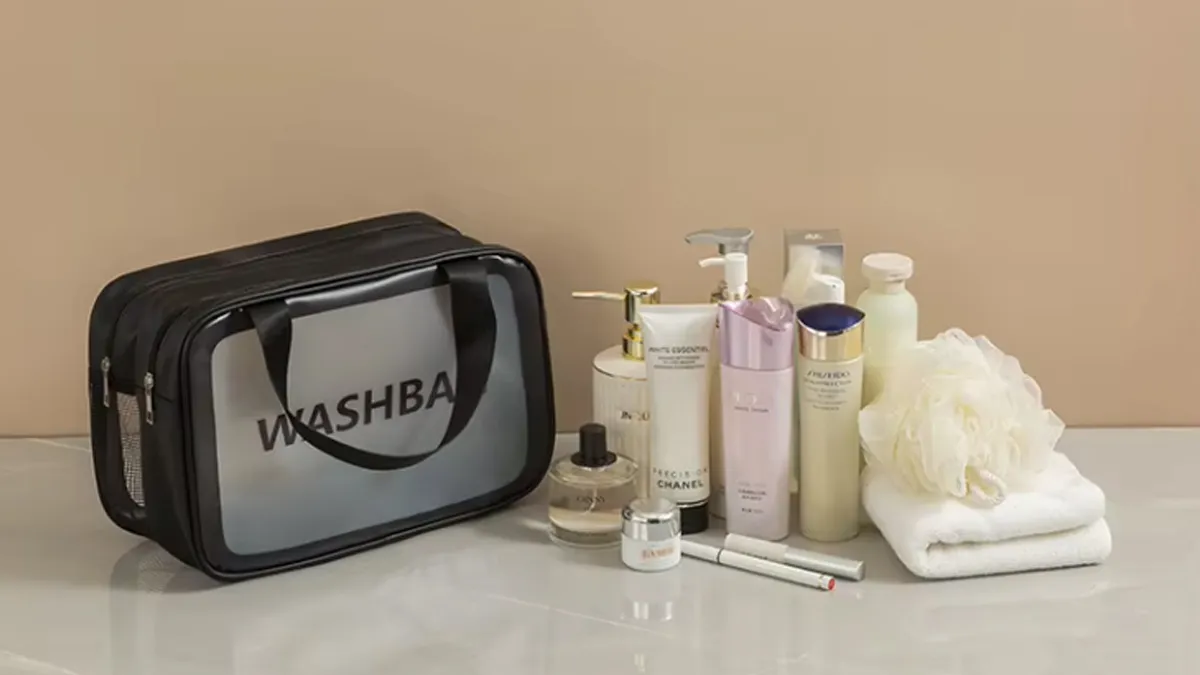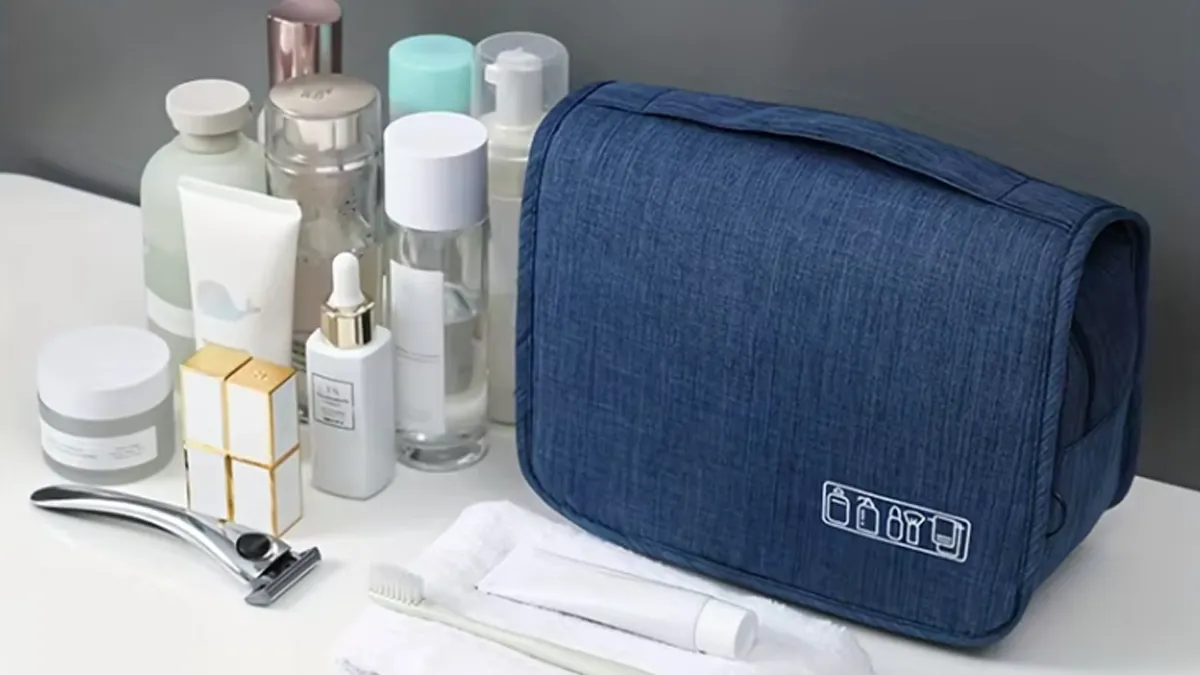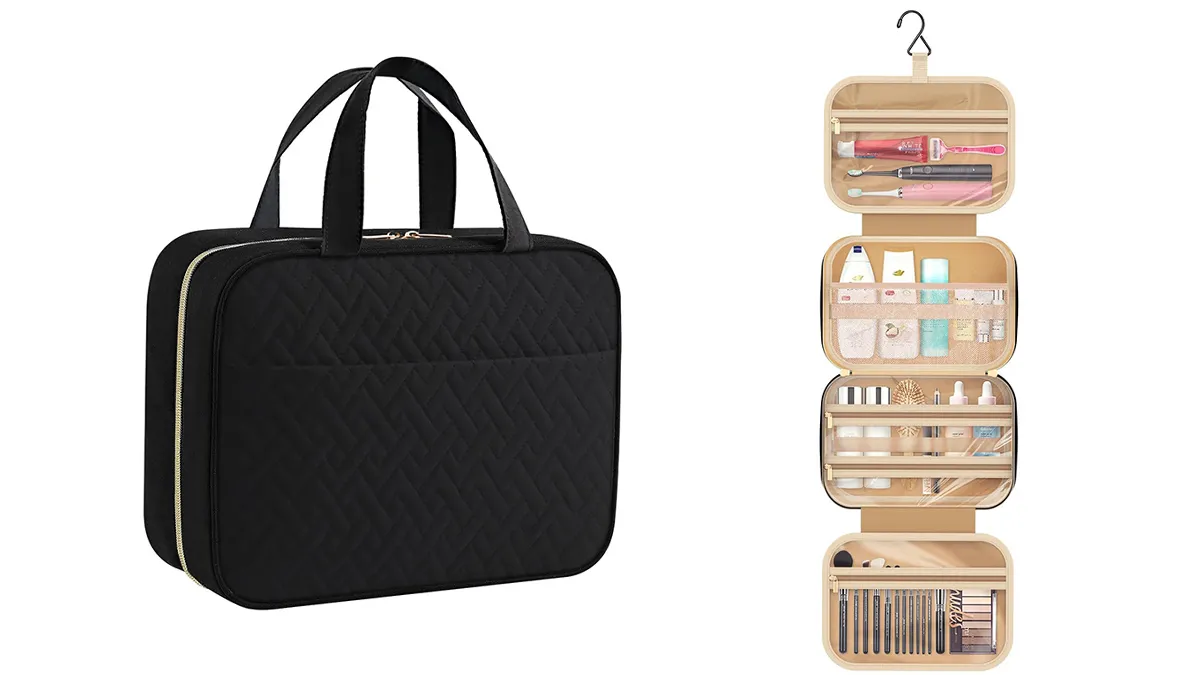A toiletry bag is a compact, portable pouch made to store and organize personal care items like toothbrushes, toothpaste, shampoo, skincare products, razors, and makeup. A well chosen toiletry bag keeps your luggage clean, speeds up your morning routine, and makes travel less stressful. This guide explains what a toiletry bag is, where it came from, the types and materials available, how to choose the right bag for your trip, packing and care tips, and common questions people ask. Read on and you will know how to pick and use the best toiletry bag for your needs.

What Is a Toiletry Bag?
Defining the Toiletry Bag
A toiletry bag provides a single place to carry and protect personal care items. It keeps small bottles upright, separates liquids from clothes, and organizes tools and cosmetics so you can find them quickly. Some bags focus on minimalism. Others focus on full organization with pockets, elastic loops, and removable trays.
Historical Roots: The Dopp Kit
The toiletry bag has an interesting origin story. The Dopp kit, a leather toiletry case invented in the early 20th century, became popular with traveling servicemen and businessmen. The Dopp kit emphasized durability and compactness. Over time, materials and designs evolved from leather boxes to lightweight technical fabrics and modular systems, but the core idea stayed the same: a durable, portable case to carry grooming essentials.
Modern Necessities: Organization and Efficiency
Modern travelers want quick access and simple maintenance. That drives features like transparent pockets for security checks, hanging hooks for bathroom use, and wipeable linings for easy cleaning. A good toiletry bag saves time and prevents wardrobe disasters from leaks.
Versatility Beyond Travel
Toiletry bags serve many roles beyond travel. People use them for home bathroom organization, gym kits, tool pouches, first aid kits, or as branded promotional gifts for clients. A single versatile design can meet several needs.
The Business Case for Brands
Branded toiletry bags offer strong marketing value. Companies use them as corporate gifts, hotel amenities, or retail items. A well made toiletry bag carries a brand message long after purchase because users keep and reuse it.
Which Types of Toiletry Bags Are Available?

Designs vary to match different use cases. Below are the most common types and what they do best.
1. TSA-Approved Clear Pouches
Clear PVC or TPU pouches speed up airport security. They let agents inspect liquids without opening the bag. These pouches work best for carry-on passengers who need fast security checks.
Pros: Fast security, easy to clean.
Cons: Less stylish, can stiffen over time.
2. Hanging Toiletry Kits
Hanging kits include a hook or strap so you can suspend the bag in a bathroom. They expose contents at eye level, which makes access fast in small hotel bathrooms.
Pros: Space saving, great access.
Cons: Requires a place to hang.
3. Zip-Around Clamshell Pouches
This design opens wide like a clamshell, offering clear internal organization and a flat workspace. It suits multi step skincare routines or packing many small tools.
Pros: Excellent organization, stable open layout.
Cons: Can be bulkier than simple pouches.
4. Structured Hard-Shell Cases
Hard-shell cases protect fragile items and keep shape under pressure. They often come with molded interiors or foam dividers for electronics or glass bottles.
Pros: Superior protection.
Cons: Heavier and less compressible.
5. Collapsible Soft Pouches
Soft, foldable pouches compress when empty and fit into tight luggage spaces. They offer light weight and flexible capacity.
Pros: Packable and light.
Cons: Lower protection for fragile bottles.
6. Hybrid Models
Hybrid bags mix rigid panels with soft sides or combine hanging capability with a clamshell opening. They aim to bring the best of several styles into one product.
Pros: Versatile, many use cases.
Cons: Complexity can raise cost.
What Materials and Linings Work Best for Toiletry Bags?

Material choices affect weight, durability, water resistance, and cleaning. Match material to how you use the bag.
Water-Resistant Exteriors
Materials like coated nylon, polyester with DWR finish, TPU laminated fabrics, and coated canvas offer water resistance and wipe clean surfaces. Those suit travel and wet environments.
Interior Linings: Leak Containment and Ease of Cleaning
A waterproof or wipeable inner lining makes cleanup simple after a spill. TPU, PVC, and laminated fabrics contain leaks while quilted or mesh linings help separate items.
Eco-Friendly and Specialty Fabrics
Recycled PET fabrics, organic cotton canvas with waterproof coating, and biodegradable blends provide greener options. These materials appeal to eco conscious buyers and brand partners.
Matching Materials to Use-Case
- Beach and pool days: TPU/PVC exterior and fully waterproof lining.
- Business travel: PU leather or coated canvas for a polished look.
- Backpacking: Light nylon with durable water repellent finish.
- Gift or retail: Premium canvas or waxed cotton for a tactile feel.
Materials Comparison Table
| Material | Strengths | Weaknesses | Typical Uses | Cleaning |
|---|---|---|---|---|
| Nylon (coated) | Lightweight, durable, dries fast | Less premium look | Travel, gym | Wipe clean or gentle wash |
| Polyester | Cost effective, color stable | Can hold odor if damp | Daily carry | Spot clean or gentle wash |
| TPU / PVC | Fully water resistant, wipeable | Less breathable, can yellow | Airport, beach | Wipe with mild soap |
| Canvas (treated) | Durable, premium feel | Heavier, needs treatment for water | Lifestyle, retail | Spot clean, hand wash |
| PU Leather | Stylish, easy wipe | Can peel over long term | Business gifts | Wipe clean, leather care |
| EVA / Silicone | Rigid protection, waterproof | Limited textures | Protect fragile items | Rinse and dry |
| Recycled Fabrics | Sustainable, marketable | May cost more | Eco lines, branded gifts | Follow fabric care |
How Do You Choose the Right Toiletry Bag for Your Trip?
Match bag size and features to trip length and travel style.
Capacity by Trip Length
Use the table below to select a starting size.
| Size (cm) | Best For | Typical Items |
|---|---|---|
| 20 × 8 × 10 (Small) | 1 to 2 day trips, daily carry | Travel size bottles, toothbrush, small creams |
| 25 × 10 × 12 (Medium) | Weekend trips, commuters | 4 to 6 travel bottles, razor, compact towel |
| 30 × 12 × 15 (Large) | Multi day travel, shared use | Full size bottles, tools, cosmetics |
| Expandable / Modular | Variable needs | Adjustable compartments, modular kits |
Weight, Packability, and Material Trade-Offs
Lighter materials save luggage weight but offer less protection. Rigid cases protect fragile items but add bulk. Choose a compromise that fits your most common trips.
Organization and Accessibility Features
Look for internal elastic loops, mesh pockets, removable pouches, and transparent compartments. Good zippers and a wide opening improve usability.
Security and TSA Compliance
For carry-on travel, keep liquids in 100 ml or smaller containers in a clear resealable bag. Transparent toiletry bags make security checks faster. Confirm airline rules before travel.
What Key Features Should You Look For in a Toiletry Bag?
A good checklist helps you pick the right model.
- Quality zippers: Choose smooth, durable zippers and consider YKK or equivalent.
- Waterproof inner lining: Prevent leaks from spreading to luggage.
- Hanging hook: Improves access on sinks or towel bars.
- Multiple compartments: Separate liquids, tools, and cosmetics.
- Rigid base or panel: Keeps items upright and protects fragile bottles.
- Easy clean fabric: Wipeable outside and inside reduces maintenance.
- Compact packing profile: Compressible design for space saving.
- Antimicrobial or odor resistant options: Useful for long use in humid climates.
Feature Priority Table
| Feature | Travel | Business | Gym |
|---|---|---|---|
| Waterproof lining | High | Medium | High |
| Hanging hook | High | Medium | High |
| Rigid protection | Medium | High | Low |
| Compact packability | High | Medium | High |
| Premium finish | Low | High | Low |
How Do You Organize and Pack a Toiletry Bag Efficiently?
Follow a simple, repeatable system to pack faster and avoid leaks.
Packing Steps and Templates
- Empty and inspect: Start with an empty clean bag.
- Sort by category: Separate oral care, hair care, skincare, and makeup.
- Use travel bottles: Transfer liquids into 30–100 ml bottles for carry-ons.
- Contain liquids: Place shampoos and lotions into small resealable bags.
- Place heavy items at bottom: Stabilize the bag with heavier items below.
- Easy access items on top: Toothbrush, deodorant, and face wash should sit near the opening.
- Label or color code bottles: Quick identification when in a hurry.
- Use small modular pouches: Keep makeup and tools separate for neat access.
Packing Templates by Trip
- Business day trip: Small zip pouch, toothbrush, travel toothpaste, deodorant, 1 small moisturizer, comb.
- Weekend getaway: Medium bag, travel shampoo, conditioner, razor, skincare set, makeup essentials.
- Family holiday: Large or multiple bags, share bulkier items, label each person’s pouch.
Common Mistakes to Avoid
- Packing full size bottles for carry-on.
- Storing damp items without drying them first.
- Mixing electronics and liquids in the same pocket.
Cleaning, Maintenance and Longevity
Treat your bag well and it will last longer.
- After each trip: Empty the bag, wipe down the interior, and air dry open.
- Spot clean quickly: Clean spills immediately to prevent stains or odors.
- Deep cleaning: Follow fabric care instructions. Machine wash only if the bag label allows and use a laundry bag.
- Protect zips and seams: Check zippers and stitching; repair small damage early.
- Storage: Store empty and dry with silica gel or a desiccant packet to avoid mold.
Quick Care Checklist
- Empty after each use.
- Wipe or hand wash as recommended.
- Air dry fully.
- Replace desiccant packs periodically.
Use Cases & Real-World Examples
- Frequent Flyers: Prefer compact, TSA friendly clear pouches or hanging kits.
- Business Travelers: Choose premium materials with sleek finish and structured panels.
- Gym Users: Need light, quick drying, antimicrobial options.
- Retail and Gifts: Canvas or premium PU leather styles work well as branded merch.
- Outdoor Enthusiasts: Waterproof and rugged materials, rigid protection for fragile items.
Conclusion
A toiletry bag brings order to travel and daily routines. Choose the type that matches your trip, pick materials that suit the environment, and use simple packing routines to avoid leaks and save time. Keep the bag clean and dry to extend its life.
We are a factory with over 16 years of experience making high quality toiletry bags. If you want to view more styles, request sample images, or get a quote, contact us and we will help you find the right solution.
FAQ
Can I bring a toiletry bag on a plane?
Yes. Airlines and airports generally allow toiletry bags in carry-on. Follow the liquid rules for your departure country: most require containers no larger than 100 ml placed in a clear resealable bag.
Will a waterproof exterior stop internal leaks?
A waterproof exterior prevents outside moisture but does not stop internal bottle leaks. Use sealed plastic bags inside the toiletry bag for full protection.
How do I prevent mold and odors?
Dry the bag fully after each use, clean spills promptly, and store with desiccant packs or in a ventilated area.
Can I put electronics like an electric toothbrush in the same bag?
Yes, but keep electronics separated from liquids. Use a different compartment or small pouch to protect chargers and batteries.
Do you accept custom logo or bulk orders?
Yes. We are a manufacturer with over 16 years of production experience. We produce a wide range of toiletry bag styles and can support sample and bulk production. Contact us for sample images and basic MOQ information.





